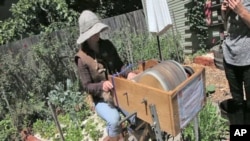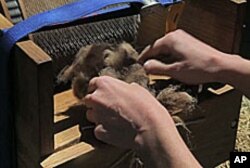Food locavores try to eat only what's grown local to their homes. In Northern California, there are also clothing locavores. The materials for their skirts, pants and socks are from locally-grown cotton and locally-bred sheep. The colors come from local plant dyes.
Keeping it close to home
That's what Katherine Jolda is up to as she pumps her bicycle pedals on a hot day in hilly suburban Fairfax, California.
The bike doesn't move because its chain has been detached from the wheel and attached to two large spinning metal drums instead.
The drums are coated with fine teeth rotating against each other. Jolda feeds raw wool, newly sheared off a sheep, into what she calls her carding contraption.
"It's carding the wool, and carding is basically brushing the wool out," she explains as the drum's teeth yank the wool in, chew on it, and then spit it out the other side. "And all the fibers are smooth and it's untangled. And from there, I make felt from it."
Jolda is teaching an energized group of women to start with wool from local sheep, and finish with clothing for Rebecca Burgess, a 32-year-old environmental activist who has vowed that every item of clothing she wears in the next year will be made from local materials.
"I thought I was quite the environmentally conscious person," says Burgess, "but I had a closet packed with clothes -15 pairs of pants, 30 shirts."
Burgess learned that the production and shipping of much of those items put some 40 times its weight in carbon dioxide into the atmosphere, and that enormous textile factories are huge fresh water polluters.
So she cut the size of her wardrobe and began to look for local sources of material for new clothes. And she found them. There's a cotton farmer 145 kilometers away and an alpaca farm 230 kilometers away. Burgess also filled her backyard garden with plants she could use as dyes for her cloth.
Fibershed Project
That's how the Fibershed Project was born.
Just like your watershed geographically defines your supply of water, a fibershed is the region that supplies your clothing fibers. Right now, for most of us, it's the entire world. For Burgess, it's anything within a radius of about 250 kilometers from her house. Dozens have joined in to help make her clothes.
Jolda's wool carding and felt-making workshop is happening in the San Francisco Bay Area, where Burgess lives along with about seven million other people. How many can have their clothing come from local sheep or cultivate indigo for color? Can this be scaled up to any practical environmental benefit?
"No, not domestically. It's not a scalable idea," says San Francisco State University Apparel Professor Connie Ulasewicz and co-author of the book, "Sustainable Design." She says the fibershed project is dependent on Burgess's extraordinary knowledge and dedication in a geographic area rich in natural plant fibers, animals and activists. "I think this is an ecological curiosity going on in Northern California."
Sustainable design
However, the professor believes criticizing the Fibershed Project because it can't be scaled up to millions of clothing buyers in a fabric-based environmental revolution misses the point. This project, she says, reflects a general movement in the garment industry toward sustainability.
"Sustainable design, green design, eco-design, how can we simplify, reduce carbon footprints?" says Ulasewicz. "There is a great movement to produce local, to manufacture local."
Burgess admits a local wardrobe is for the rare few, like her, who have the time, skills and supportive friends to design, dye, weave and sew. But, she says, the Fibershed Project also illustrates the grand ecological errors of the textile industry.
Wasted wool
Take the wool being fed into the backyard bicycle carding mill.
Northern California's sheep are raised for meat, not wool. The ranchers had been throwing the wool into landfills, more than 30,000 kilos of it a year, until Burgess started gathering some for her clothes. The rest still ends up in landfills, which does not make sense to Burgess.
"We're importing millions of pounds of wool from New Zealand," she says. "It's being milled in China, and yet we're throwing wool away here."
Since this all started with Burgess's realization that her commercially-made clothes create a huge carbon imprint, she's now calculating the environmental impact of her fibershed clothes.
She wants to determine what her carbon output is when she drives to sheep ranches to get wool or transports locally-grown cotton just for her use. How much water does it take to wash the wool and cotton or to irrigate her dye plants? How much energy is needed to boil water to make the dyes, run her sewing machine and light her workshop?
Burgess estimates that fibershed clothes are less environmentally costly but admits more study is needed. In the meantime, 'dressing locally' makes her feel better about doing her part for the environment.












